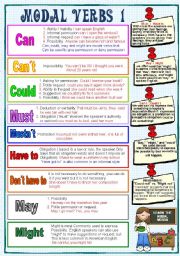


School subject: English as a Second Language (ESL) Grade/level: pre-intermediate. Students match the rules from the grammar guide with pictures and sentences they then do a multiple choice exercise and finish with a gap filling exercise based on pictures. Ought to are examples of semi-modal verbs. Modal verbs: can, must, mustn't, should, have to. Semi-modal verbs are composed of two or more separate words ending with ‘to’. Will you join us for coffee? Won't you come in? I shall be in London on Monday (or I'll be. I've revised so I should be ready for the test. You should take an umbrella in case it rains. You must be tired after your long journey. You look very confused by the homework, Clive. The company go bankrupt if they dont find a lot of money quickly should shouldnt might. The President may come to our offices if the meeting finishes before 5 pm. He won medals and championships had to can could. Learn Real English, ESL videos, esl listening exercises, english grammar exercises, esl english, learn english conversation. Can is both an auxiliary and a modal verb and means to be able to do something. The subject: Can you? NOT Do you can? MODALĬan I come with you? ('May' is also used.)Ĭharlie could swim when he was four years old.Ĭould you tell me the way to the station please? The verb 'can' is the most widely used verb of its kind. 5) Questions are formed by inversion with 4) The negative is formed by the addition of not / n’t:ĭon’t can. 3) They do not have a past form: He/she canted. Modal verbs have the following characteristics: 1) They do not have participle or infinitive forms 2) They do not take the ending -(e)s in the third-person singular. Possibility, prediction, speculation, deduction and necessity. Modal verbs are a type of auxiliary verb which express the mood of another verb.


 0 kommentar(er)
0 kommentar(er)
